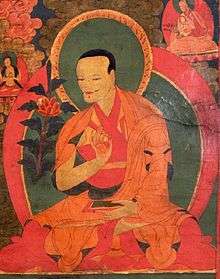Gorampa
Gorampa Sonam Senge (Wylie: go rams pa bsod nams seng ge , 1429-1489[1]) was an important philosopher in the Sakya school of Tibetan Buddhism. He was the author of a vast collection of commentaries on sutra and tantra whose work was influential throughout Tibetan Buddhism. He established one of the definitive Tibetan understandings of the Prasaṅgika model of the Madhyamaka school of philosophy. He was the student of Rongtön (Rongtön Shéja Künrik, Wylie: rong ston shes bya kun rig ).[1] He founded the Thuptén Namgyél Monastery in Tanag (Wylie: rta nag thub bstan rnam rgyal gling ), which is just north of Shigatse.

Philosophic views
One of his most important and popular works is Distinguishing the Views (Tibetan: ལྟ་བའི་ཤན་འབྱེད, Wylie: lta ba'i shan 'byed ), in which he argues for his view of Madhyamaka. He and other Sakya teachers classify themselves as presenting the "Freedom from Proliferation" (Tibetan: སྤྲོས་བྲལ་, Wylie: spros bral ) Madhyamaka.[2]
A critic of both Dolpopa and Je Tsongkhapa, he joined into the polarized Prasangika and Svatantrika debate at that time, but he attempted an allegedly 'moderate' position between the 'extremes' he saw in their opposing views. Dolpopa disregarded the distinction between Prasangika and Svatantrika and considered them a later elaboration that damages the non-conceptual view of the ultimate. Gorampa sides more closely with Tsongkhapa that a distinction is reasonable to make and he also critiques the traditional Svatantrika approach. However, he disagreed with Tsongkhapa's "Eight Difficult Points" and instead posited his own sixteen points of distinction between the two views.
Of particular note in his characterization, he does not agree with Tsonghkapa that the Prasangika and Svatantrika methods produce different results nor that the Prasangika is a "higher" view. He does also critique the Svatantrika approach as having too much reliance on logic, because in his view the component parts of syllogistic logic are not applicable in the realm of the ultimate. But this critique is constrained to the methodology, and he believed both approaches reach the same ultimate realization.[3]
Nevertheless, he shared some strong doubts about Je Tsongkhapa. Gorampa insinuated that Tsongkhapa's conversations with Manjusri were actually with a demon:[note 1]
"Gorampa, in the Lta ba ngan sel (Eliminating the Erroneous View), accuses Tsongkhapa of being "seized by demons" (bdud kyis zin pa) and in the Lta ba'i shan 'byed (Distinguishing Views) decries him as a "nihilistic Madhyamika" (dbu ma chad lta ba) who is spreading "demonic words" (bdud kyi tshig)."[5]
See also
Notes
References
Sources
- Cabezon, Jose Ignacio & Geshe Lobsang Dargyay. (2007) Freedom from Extremes: Gorampa's "Distinguishing the Views" and the Polemics of Emptiness (Studies in Indian and Tibetan Buddhism) Wisdom. ISBN 0-86171-523-3
- Dreyfus, Georges B. J. and McClintock, Sara (2003) The Svatantrika-Prasangika Distinction ISBN 0-86171-324-9
- Kassor, Constance (2011) 'Gorampa [go rams pa]' in Stanford Encyclopedia of Philosophy
- Thakchoe, Sonam (2007) The Two Truths Debate: Tsongkhapa and Gorampa on the Middle Way Wisdom ISBN 0-86171-501-2